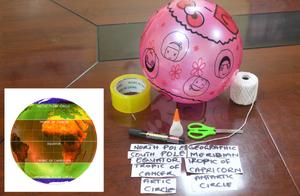Glossary term: Tropic
Description: The tropics are two lines of latitude on the Earth: the Tropic of Cancer (at 23°26′11.2″ N) and the Tropic of Capricorn (at 23°26′11.2″ S).
The Sun's position in the sky, relative to stars and other celestial objects, changes over the course of a year, moving through the constellations of the Zodiac. From the March equinox to the September equinox, the Sun is in the northern hemisphere. At approximately local midday on the June solstice, the Sun is directly overhead at the Tropic of Cancer. Between the September equinox and March equinox, the Sun is in the southern hemisphere. At approximately local midday on the December solstice, the Sun is directly overhead at the Tropic of Capricorn. During the equinoxes in March and September the Sun reaches directly overhead at the equator.
The region on the Earth between the two tropics is often called "the tropics". Here the Sun is directly overhead at local midday on two days a year.
The latitude of the two tropics above and below the equator is the angle at which the Earth's axis is tilted with respect to its orbit around the Sun.
The tropics are named after the constellations of Cancer and Capricorn which the Sun appeared to pass through during the solstices two thousand years ago. Precession of the Earth's axis means that the Sun no longer appears to be in either of these constellations at the solstices.
Related Terms:
See this term in other languages
Term and definition status: This term and its definition have been approved by a research astronomer and a teacher
The OAE Multilingual Glossary is a project of the IAU Office of Astronomy for Education (OAE) in collaboration with the IAU Office of Astronomy Outreach (OAO). The terms and definitions were chosen, written and reviewed by a collective effort from the OAE, the OAE Centers and Nodes, the OAE National Astronomy Education Coordinators (NAECs) and other volunteers. You can find a full list of credits here. All glossary terms and their definitions are released under a Creative Commons CC BY-4.0 license and should be credited to "IAU OAE".
If you notice a factual error in this glossary definition then please get in touch.
Related Activities
Discover Earth's climate with a balloon
astroEDU educational activity (links to astroEDU website) Description: Discover the secrets of Earth's climate zones with a hands-on experience
License: CC-BY-4.0 Creative Commons Attribution 4.0 International (CC BY 4.0) icons
Age Ranges:
8-10
, 10-12
Education Level:
Middle School
, Primary
Areas of Learning:
Fun activity
, Guided-discovery learning
, Modelling
, Observation based
, Project-based learning
, Social Research
Costs:
Low Cost
Duration:
45 mins
Group Size:
Group
Skills:
Asking questions
, Constructing explanations
, Developing and using models









